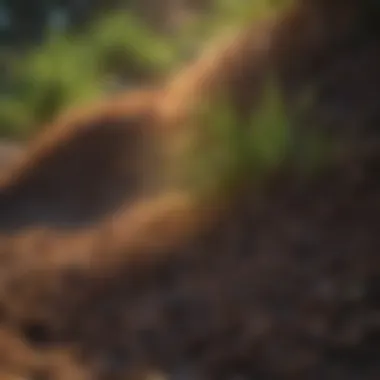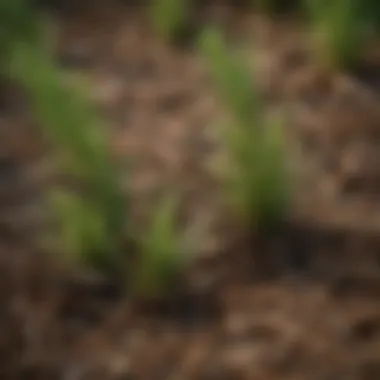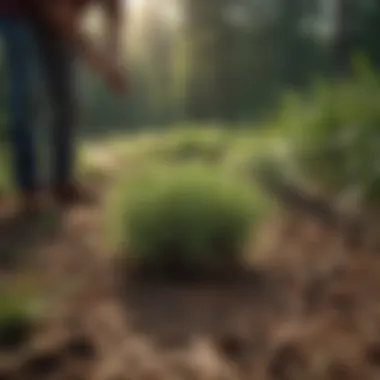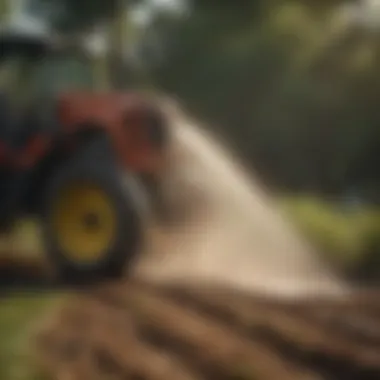Effective Weed Management in Pine Straw Mulch


Overview of the Topic
Definition and Importance
Managing weeds in pine straw mulch environments is crucial for maintaining healthy landscapes. Pine straw is a popular mulching material due to its natural look and ability to retain soil moisture. However, it also provides a suitable habitat for various weed species. Effective weed management in these areas is vital as it contributes to the overall health of gardens and commercial landscapes, and helps prevent competition for nutrients and water among plants.
Current Trends
Recently, there has been a shift toward more sustainable and ecologically friendly practices in weed management. This includes integrating organic methods alongside conventional herbicides. Many landscape professionals are now more aware of the ecological impacts of their choices. They are opting for solutions that not only control weeds but also support soil health and biodiversity.
Key Techniques and Practices
Step-by-Step Guide
- Identify Common Weeds: Start by learning the types of weeds prevalent in pine straw. Familiarity with species like dandelion and clover allows for targeted management.
- Manual Removal: Hand-pulling is both effective and environmentally friendly. It is best to remove weeds when the soil is moist to ensure the entire root system comes out.
- Herbicide Application: For tougher weeds, using herbicides may be necessary. Selective herbicides can target specific weeds while sparing desirable plants. Always follow the application guidelines to minimize ecological impact.
- Organic Alternatives: Consider applying organic solutions such as vinegar or salt. These methods can be effective for controlling young weeds but should be applied carefully to avoid harming surrounding plants.
- Preventive Measures: After removing weeds, maintain a thick layer of pine straw mulch. This will suffocate any remaining weeds and prevent new ones from emerging.
Tools and Equipment Needed
To effectively manage weeds, certain tools will enhance your efforts:
- Hand trowel for digging out weeds
- Garden hoe for cultivating soil
- Sprayer for applying herbicides or organic solutions
- Gloves to protect hands during manual removal
Challenges and Solutions
Common Obstacles
Managing weeds in pine straw mulch can present unique challenges. These include:
- Persistent Weeds: Certain weeds have robust root systems and can easily regrow.
- Environmental Concerns: Choosing the right method that aligns with sustainability goals can be difficult.
Innovative Solutions
To navigate these challenges, consider implementing these solutions:
- Integrated Weed Management: Combine various techniques for a more comprehensive approach. Manual removal, herbicides, and organic solutions can all be used in tandem.
- Regular Monitoring: Periodic checks of your pine straw mulch can help catch weed issues early, allowing for prompt action.
Managing weeds effectively is not merely about eradication; it is about finding a balance that promotes both agricultural productivity and ecological harmony.
Through understanding and applying these strategies, agricultural professionals can manage weeds efficiently while maintaining the health of their landscapes. This not only supports sustainable practices but also ensures an aesthetically pleasing environment.
Understanding Pine Straw as a Mulch
Understanding the role of pine straw as mulch is crucial for effective weed management. Pine straw mulch is lauded for its unique properties that not only enhance plant growth but also suppress weeds. In this section, we will delve into the definition and characteristics of pine straw, its benefits in landscaping, and its common uses in agriculture. Collectively, these elements provide a foundational understanding important for anyone involved in land management or gardening.
Definition and Characteristics of Pine Straw
Pine straw consists of fallen needles from pine trees. These needles accumulate naturally on the forest floor and are often harvested for mulch purposes. This type of mulch is porous and lightweight, allowing air and water to penetrate easily. Pine straw naturally retains moisture, reducing the reliance on frequent watering. Its long-lasting nature means it can break down slow enough to provide nutrients over time without the need for constant replacement. Additionally, the aesthetic appeal of its natural brown color can complement various landscaping designs.
Benefits of Using Pine Straw in Landscaping
The use of pine straw in landscaping presents numerous benefits. First, it improves soil moisture retention, which can be essential during dry spells. Unlike other mulches, pine straw prevents soil erosion, especially on slopes. Moreover, it fosters an environment that encourages beneficial earthworms and microorganisms essential for nutrient recycling in the soil.
Some additional benefits include:
- Weed suppression: Its dense cover naturally blocks light, inhibiting weed seed germination.
- Temperature regulation: It helps maintain a more consistent soil temperature.
- pH balance: Pine straw contributes to soil acidity, which can aid certain plants such as azaleas and blueberries.
Common Uses of Pine Straw in Agriculture


In agricultural settings, pine straw serves several important purposes. Farmers and gardeners utilize it not only for its ecological benefits but also for economic efficiency. Its use allows for reduced irrigation needs and improved soil health over time.
Some common applications in agriculture include:
- Row cropping: Pine straw is used as a mulch in row crops to help manage soil temperature and moisture.
- Orchard management: It can provide an effective ground cover under fruit trees, helping to reduce competition from weeds.
- Erosion control: Its application on sloped areas can help stabilize the soil and reduce runoff during rainfall.
Pine straw is more than just a decorative element; it serves essential ecological roles that benefit both landscapes and agricultural systems.
Understanding the characteristics and applications of pine straw is vital for implementing effective weed management strategies. This foundational knowledge highlights how using the right type of mulch can contribute to healthier plants and reduced competition with weeds.
Challenges of Weeds in Pine Straw
Managing weeds in pine straw mulch settings involves several challenges that require attention for effective control and healthy landscaping. This particular environment is favorable for many weed species due to the favorable microclimate created by the pine straw's composition. Unlike other types of mulch, pine straw can harbor weeds, leading to increased competition for resources among plants. Additionally, understanding these weed species and their growth patterns plays a crucial role in developing management strategies. Farmers and landscape enthusiasts must be aware of these dynamics to maintain healthy gardens and promote sustainable practices.
Types of Weeds Commonly Found in Pine Straw
Pine straw environments attract a variety of weeds. These can be categorized into annual weeds, perennial weeds, and invasive species, each presenting unique challenges.
Annual Weeds
Annual weeds are crucial to discuss due to their capability to complete their life cycle within a single growing season. They typically germinate in spring, grow rapidly, and produce seeds by the end of summer. These weeds can easily overcrowd seedlings and established plants in mulched areas. Their key characteristic is the rapid reproduction cycle, making them a popular concern for gardeners.
Advantages and Disadvantanges: While they often appear and disappear quickly, they can still effectively reduce the growth space available for desirable plants. Their seeds can spread easily, leading to potential re-infestation each season if not controlled.
Perennial Weeds
Perennial weeds, unlike annuals, live for more than two years. These weeds tend to establish deep root systems and can be particularly resilient against removal efforts. Their presence in pine straw mulches can significantly impede plant health by competing for nutrients below the surface. A notable characteristic is their ability to return each season, which complicates management efforts.
Advantages and Disadvantages: On one hand, their endurance makes them a strong competitor for survival, resulting in a long-term presence if unmanaged. On the other hand, their deep roots make them easier to target with specific removal techniques, but this often demands persistence and timing to achieve effective removal.
Invasive Species
Invasive species are another major concern in pine straw settings. These are non-native plants that spread aggressively, outcompeting native plants and altering local ecosystems. Their key characteristic is adaptability to different soil and climate conditions, which allows them to thrive in various environments, including those with pine straw.
Advantages and Disadvantages: The significant downside is their ability to dominate landscapes, pushing out native flora. This can lead to reduced biodiversity and can disrupt local ecosystems, making control measures absolutely necessary. Their rapid growth and spread can underscore the need for preemptive measures to curb their infestations.
Impact of Weeds on Plant Growth
Weeds have a detrimental impact on the growth of desirable plants by competing for essential resources like sunlight, water, and nutrients. Understanding this competition is key for anyone looking to maintain healthy and flourishing landscapes.
Weed Competition for Resources
Weeds fundamentally challenge the overall health of various landscapes. The competition for resources often leads to diminished growth rates in favorable plants, affecting the yield and aesthetic appeal of gardens. Awareness of these issues is crucial for effective management in pine straw environments.
Weed Control Methods
Weed control is crucial for maintaining healthy landscapes using pine straw mulch. Effective management of weeds ensures that desired plants have the nutrients, water, and sunlight they need to thrive. Weeds, if left unchecked, can dominate a growing space, leading to competition for resources. Approaching weed control with various strategies can help to mitigate this issue. The methods outlined below provide options for different situations and preferences.
Manual Removal Techniques
Manual removal of weeds can be straightforward and environmentally friendly. It allows for the targeted elimination of unwanted plants without the use of chemicals. This method can be especially useful in smaller areas or where specific weeds are present.
Hand Pulling
Hand pulling is perhaps the simplest method of weed management. It involves removing weeds by pulling them out of the ground, roots and all. One key characteristic of hand pulling is its accessibility. Practically anyone can do it without needing significant tools or training. It is a beneficial choice in maintaining small garden beds or confined spaces where weeds might disrupt growth of cultivated plants.
However, there are disadvantages. Hand pulling can be labor-intensive and time-consuming, particularly for larger areas. There is also the risk that if the entire root system is not removed, weeds may regrow.


Using Tools for Thinning
Using tools for thinning involves employing implements such as hoes or hand cultivators to uproot weeds. This technique is effective for larger patches of weeds. The key characteristic of using tools is the increased speed and efficiency gained versus hand pulling. It is a popular choice among those dealing with extensive areas of pine straw where labor demands are higher. Tools can penetrate deeper into the soil, aiding in the removal of stubborn root systems.
Nevertheless, one must be careful with tools as improper use can damage nearby desired plants. Additionally, they may require regular maintenance to remain effective, adding to the overall effort involved in maintaining one’s landscape.
Chemical Control: Herbicide Application
Herbicides can offer a practical solution for controlling weeds in pine straw environments. They are specifically designed to target unwanted plants while leaving cultivated species unharmed when applied correctly. Using herbicides can lead to timely interventions that free up resources for usable plants.
Choosing the Right Herbicide
Choosing the right herbicide is critical for effective weed management. This means assessing the types of weeds and the specific conditions of your landscape. Different herbicides target various weed types—some are designed for annual weeds, while others focus on perennial species. This method is beneficial because it allows for targeted results and can be formulated for specific needs.
However, misapplication or choosing the wrong herbicide can cause significant harm to surrounding vegetation. It is imperative to read labels thoroughly and follow instructions to minimize risks.
Application Techniques and Safety
Application techniques and safety are essential components of using chemical herbicides. Knowing when and how to apply herbicides ensures effectiveness while safeguarding the environment. For instance, applying herbicides during calm weather prevents drift onto undesired areas. This method is favorable for those who wish to maintain a larger area without resorting to labor-intensive methods.
On the downside, safety measures must never be overlooked. Personal protective equipment is crucial, as chemicals pose health risks if mishandled.
Organic Alternatives to Herbicides
Organic alternatives to chemical herbicides are gaining popularity among gardeners and farmers. They work to suppress weeds using natural methods, promoting a healthier ecological balance.
Vinegar Solutions
Vinegar solutions are a non-toxic option for managing weeds. The acetic acid found in vinegar can effectively kill many types of weeds. One benefit of using vinegar is its accessibility; it can typically be found at any grocery store. This method suits gardeners looking for herbicide-free solutions.
However, vinegar may not be selective and can affect desired plants in its vicinity. It can also require multiple applications, especially for persistent weed species.
Boiling Water Treatments
Boiling water treatments are another organic method for controlling weeds. Pouring boiling water directly on weeds kills them through thermal shock. The primary characteristic of this method is its immediate effect. It brings instant results without the risk of chemical exposure to surrounding life.
The disadvantage is related to practicality and safety. It necessitates cautious handling to avoid burns or unintended damage to nearby plants. This method works effectively in smaller patches or areas where precision can be maintained.
Preventive Measures to Minimize Weed Growth
Preventive measures can significantly reduce the effort needed for weed control in the first place. Addressing weed growth proactively can lead to healthier landscaping with lower maintenance.
Proper Mulch Depth
Proper mulch depth is vital in suppressing weed growth. Adequate thickness of pine straw can discourage weeds from taking root. A depth of at least three inches is often recommended. This prevents light from reaching weed seedlings, which is fundamental to their growth. This method is primarily advantageous as it works both as a weed barrier and helps retain moisture for existing plants.
On the downside, if too much mulch is applied, it can suffocate desired plants and foster a different set of issues such as mold. Thus, a careful balance is necessary.
Regular Maintenance
Regular maintenance is key to keeping weeds at bay. This includes consistently monitoring the landscape and promptly addressing any signs of weed emergence. Frequent checks help identify problematic trends early.
The key advantage of regular maintenance is its encompassing nature; it promotes overall plant health as well. However, it requires a time commitment that may not be feasible for everyone. Proper scheduling can mitigate this concern, making it manageable.
Maintaining a proactive approach toward weed control in pine straw mulch can save time, effort, and reduce resource competition.
Sustainable Practices for Weed Management


Managing weeds effectively in pine straw mulch requires a nuanced approach. One that leans towards sustainability helps maintain the delicate balance between the needs of your garden and the wider ecosystem. By implementing sustainable practices, you can reduce the reliance on chemicals, lower maintenance efforts, and promote soil health.
The Role of Mulch in Sustainable Gardens
Mulch serves multiple functions in sustainable gardening. It acts as a barrier against weeds, conserving moisture and regulating soil temperature. Pine straw, in particular, is an excellent mulch choice due to its acidic nature, beneficial for certain plants. When applied correctly, it can suppress the germination of weed seeds by blocking sunlight. Additionally, it decomposes over time, enriching the soil with organic matter and nutrients, which enhances soil structure and fertility.
- Soil Enhancement: Pine straw adds organic matter to the soil, which improves its physical and chemical properties.
- Moisture Conservation: It helps retain soil moisture, reducing the need for frequent watering.
- Weed Suppression: By covering the ground, it limits the growth of unwanted plants.
This multifaceted contribution makes mulch essential in any sustainable gardening strategy.
Companion Planting to Deter Weeds
Companion planting involves strategically placing certain plants together to maximize their growth and health while minimizing pests and weeds. Some plant types naturally repel weeds by outcompeting them for resources. For example, planting fast-growing crops like radishes can shade the soil, preventing weeds from sprouting. Other herbs, such as basil or rosemary, can deter specific weed species while also providing culinary benefits.
- Outcompeting Weeds: Choose crops or flowers that can grow taller or spread wider, thus creating a living barrier against weeds.
- Mutual Benefits: Some companion plants can attract beneficial insects that prey on pests, further aiding in plant growth and health.
By intertwining companion planting into your weed management practices, you strengthen your garden's ecosystem and reduce weed pressure.
Using Cover Crops for Soil Health
Cover crops are often overlooked but are vital for maintaining soil health and combating weeds in pine straw mulch areas. These plants grow during the off-season and serve various purposes. They increase organic matter in the soil, help prevent erosion, and improve soil structure.
- Nitrogen Fixation: Certain cover crops, like clover, can fix nitrogen in the soil, making it available for subsequent crops.
- Weed Suppression: When allowed to grow, cover crops can smother weeds, effectively reducing their populations.
- Soil Improvement: They create a network of roots that helps soil aeration and water infiltration.
Utilizing cover crops can enhance the resilience of your garden while managing weed populations effectively.
Ultimately, integrating these sustainable practices fosters a healthier growing environment, promoting long-term ecological balance.
Embracing these methods not only aligns with an ecological conscience but also provides practical benefits for both the gardener and the plants.
Monitoring and Evaluating Weed Control Success
Monitoring and evaluating weed control success is pivotal in managing weeds in pine straw mulch environments. Without a systematic approach, it becomes challenging to gauge the effectiveness of various methods used to thwart weed growth. Successful monitoring helps in adapting strategies that ensure long-term weed management effectiveness while preserving the integrity of the mulch layer. This section is aimed at providing clarity on how to set benchmarks for weed management and assessing the efficacies of specific control methods.
Setting Benchmarks for Weed Management
Establishing clear benchmarks is essential for effective weed management. It serves as a guide to measure progress in controlling weed populations. Key considerations when setting benchmarks include:
- Identification of Weed Species: Knowing which weeds to target helps in creating specific action plans.
- Monitoring Frequency: Regularly schedule evaluations to understand changes in weed presence. Monthly checks maybe effective during peak growing seasons.
- Assessment Criteria: Use quantifiable metrics, such as the number of weeds per square meter, to objectively assess the situation.
Keep in mind that this process also aids in resource allocation. More resources can be directed toward areas showing persistent weed problems, ensuring the most effective outcomes.
Assessing the Efficacy of Control Methods
Once benchmarks are set, assessing the efficacy of control methods becomes crucial. Here, the focus is on who effective the employed strategies are in reducing weed populations. This assessment can be achieved through several steps:
- Compare Pre- and Post-Treatment Data: By documenting weed counts before and after applying control methods, one can determine the success rate of those methods.
- Evaluate Plant Health: Besides counting weeds, examining the health of desired plants facilitates an understanding of the indirect effects of weed management. Healthier plants usually indicate successful control methods.
- Adapt and Revise Strategies: If certain methods underperform, it is essential to record these findings and modify the approach accordingly.
Effective weed management must factor in both the success of weed control methods and the health of the ecosystem.
Culmination and Future Considerations
Managing weeds effectively in pine straw mulch is essential for thriving gardens and landscapes. This article outlined significant strategies to control weed growth. The benefits extend beyond aesthetics; they influence soil health and deter invasive species. Balancing weed control with ecological health is a critical consideration in these efforts. There is a continuous push for practices that promote sustainability while also ensuring that the desired plants can thrive.
Balancing Weed Control with Ecological Health
Weed control methods can conflict with ecological health. While tackling weeds, it’s important to consider the entire ecosystem. Over-reliance on herbicides can lead to adverse effects, including the harm of beneficial insects and soil organisms. Careful selection of control methods, such as using organic approaches or integrated pest management, helps maintain the balance. Companion planting can deter weeds naturally. Planting species that foster biodiversity will help protect against overgrowth by undesired plants while supporting the local ecosystem. Additionally, monitoring soil health ensures that practices remain sustainable and effective.
Research Directions in Weed Management
Future research in weed management should address the challenges posed by climate change. Developing drought-resistant strategies can enhance resilience in pine straw mulch gardens. Moreover, investigations into alternative organic treatments will provide more tools for farmers and enthusiasts. Emphasis should also be placed on the development of improved crop rotation techniques and cover crop usage. Engaging with agricultural technology may lead to innovative solutions for identifying and managing weeds with precision. Ultimately, studies that explore the interactions of weeds with various plant species will provide valuable insights for improved management practices.
"Weeds are more than just an inconvenience; they can significantly impact the health of gardens if left unchecked. Understanding their management is crucial for a sustainable future."
This article establishes a foundation for understanding the complexities of weed management in pine straw mulch environments. Fostering knowledge through research and practical strategies will help achieve well-balanced landscapes. Advances in science and sustainable practices must be at the forefront to keep evolving in the battle against weeds.



